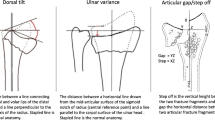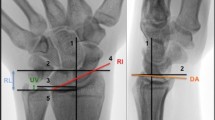Abstract
Introduction
The association between body mass index (BMI) and functional outcomes is unknown in elderly individuals with distal radius fracture (DRF).
Objective
The aim of this study is to evaluate if there is association between BMI and functional outcomes in patients older than 60 years with DRF treated conservatively.
Materials and Methods
A prospective observational study was performed. A total of 228 patients with extra-articular DRF were prospectively recruited. All patients were categorized by their BMI as normal, overweight, or obese. Functional outcomes were assessed after cast removal and at 1-year follow-up. The Disabilities of the Arm, Shoulder and Hand Outcome Measure (DASH), and Patient-Rated Wrist Evaluation (PRWE) questionnaires were used to assess upper limb and wrist/hand function, respectively, while the Jamar Dynamometer was used to assess grip strength.
Results
Of the total number of patients, 184 were female (80.7%), 87 were overweight (38.2%), and 111 were obese (48.7%). After cast removal, the correlations between BMI and functional outcomes were DASH 0.06 (p = 0.578), PRWE 0.04 (p = 0.692), and grip strength − 0.02 (p = 0.763). At 1-year follow-up, the correlations were DASH 0.55 (p = 0.036), PRWE 0.32 (p = 0.041), and grip strength − 0.21 (p = 0.043).
Conclusion
This study suggests that at 1-year follow-up, there was a low-to-moderate association between BMI and poor functional outcomes in elderly patients with extra-articular DRF treated conservatively.
Level of Evidence
Level IV, observational prospective study.
Similar content being viewed by others
References
Singer, B. R., McLauchlan, G. J., Robinson, C. M., & Christie, J. (1998). Epidemiology of fractures in 15 000 adults: The influence of age and gender. Journal of Bone and Joint Surgery, 80(2), 243–248. https://doi.org/10.1302/0301-620x.80b2.7762.
MacIntyre, N. J., & Dewan, N. (2016). Epidemiology of distal radius fractures and factors predicting risk and prognosis. Journal of Hand Therapy, 29(2), 136–145. https://doi.org/10.1016/j.jht.2016.03.003.
Ray, N. F., Chan, J. K., Thamer, M., & Melton, L. J. (1997). Medical expenditures for the treatment of osteoporotic fractures in the United States in 1995: Report from the National Osteoporosis Foundation. Journal of Bone and Mineral Research, 12(1), 24–35. https://doi.org/10.1359/jbmr.1997.12.1.24.
Diaz-Garcia, R. J., Oda, T., Shauver, M. J., & Chung, K. C. (2011). A systematic review of outcomes and complications of treating unstable distal radius fractures in the elderly. Journal of Hand Surgery America, 36(5), 824-835.e2. https://doi.org/10.1016/j.jhsa.2011.02.005.
Ebinger, T., Koehler, D. M., Dolan, L. A., Mcdonald, K., & Shah, A. S. (2016). Obesity increases complexity of distal radius fracture in fall from standing height. Journal of Orthopaedic Trauma, 30(8), 450–455. https://doi.org/10.1097/BOT.0000000000000546.
Acosta-Olivo, C., Gonzalez-Saldivar, J. C., Villarreal-Villarreal, G., Torres-Botello, A., Gomez-Garcia, E., Tamez-Mata, Y., & Peña-Martinez, V. (2017). Correlation between obesity and severity of distal radius fractures. Orthopaedic & Traumatology: Surgery & Research, 103(2), 199–202. https://doi.org/10.1016/j.otsr.2016.12.007.
Jones, C. B. (2011). Management of upper extremity injuries in obese patients. Orthopaedic Clinics of North America, 42(1), 11–19. https://doi.org/10.1016/j.ocl.2010.08.002.
Premaor, M. O., Pilbrow, L., Tonkin, C., Parker, R. A., & Compston, J. (2010). Obesity and fractures in postmenopausal women. Journal of Bone and Mineral Research, 25(2), 292–297. https://doi.org/10.1359/jbmr.091004.
Hooker, E. R., Shrestha, S., Lee, C. G., Cawthon, P. M., Abrahamson, M., Ensrud, K., et al. (2017). Obesity and falls in a prospective study of older men: The osteoporotic fractures in men study. Journal of Aging and Health, 29(7), 1235–1250. https://doi.org/10.1177/0898264316660412.
Lichtman, D. M., Bindra, R. R., Boyer, M. I., Putnam, M. D., Ring, D., Slutsky, D. J., et al. (2010). Treatment of distal radius fractures. Journal of American Academy of Orthopaedic Surgeons, 18(3), 180–189. https://doi.org/10.5435/00124635-201003000-00007.
Alemdaroǧlu, K. B., Iltar, S., Aydoǧan, N. H., Say, F., Kilinç, C. Y., & Tiftikçi, U. (2010). Three-point index in predicting redisplacement of extra-articular distal radial fractures in adults. Injury, 41(2), 197–203. https://doi.org/10.1016/j.injury.2009.08.021.
Gutiérrez-Espinoza, H., Arriagada-Núñez, V., Araya-Quintanilla, F., Zavala-González, J., Rubio-Oyarzún, D., Sfeir-Castro, R., & Gana-Hervias, G. (2018). Physical therapy in patients over 60 years of age with a massive and irreparable rotator cuff tear: A case series. Journal of Physical Therapy Science, 30(8), 1126–1130. https://doi.org/10.1589/jpts.30.1126.
Kreder, H. J., Hanel, D. P., McKee, M., Jupiter, J., McGillivary, G., & Swiontkowski, M. F. (1996). X-ray film measurements for healed distal radius fractures. Journal of Hand Surgery America, 21(1), 31–39. https://doi.org/10.1016/S0363-5023(96)80151-1.
WHO. (2015). Preventing and managing the global epidemic of obesity. WHO. World Health Organization.
Hudak, P. L., Amadio, P. C., & Bombardier, C. (1996). Development of an upper extremity outcome measure: The DASH (disabilities of the arm, shoulder, and head). American Journal of Industrial Medicine, 29(6), 602–608. https://doi.org/10.1002/(SICI)1097-0274(199606)29:6%3c602::AID-AJIM4%3e3.0.CO;2-L.
MacDermid, J. C. (1996). Development of a scale for patient rating of wrist pain and disability. Journal of Hand Therapy, 9(2), 178–183. https://doi.org/10.1016/S0894-1130(96)80076-7.
Trampisch, U. S., Franke, J., Jedamzik, N., Hinrichs, T., & Platen, P. (2012). Optimal jamar dynamometer handle position to assess maximal isometric hand grip strength in epidemiological studies. Journal of Hand Surgery America, 37(11), 2368–2373. https://doi.org/10.1016/j.jhsa.2012.08.014.
Kleinlugtenbelt, Y. V., Krol, R. G., Bhandari, M., Goslings, J. C., Poolman, R. W., & Scholtes, V. A. B. (2018). Are the patient-rated wrist evaluation (PRWE) and the Disabilities of the Arm, Shoulder and Hand (DASH) questionnaire used in distal radial fractures truly valid and reliable? Bone & Joint Research, 7(1), 36–45. https://doi.org/10.1302/2046-3758.71.BJR-2017-0081.R1.
Mukaka, M. M. (2012). Statistics corner: A guide to appropriate use of correlation coefficient in medical research. Malawi Medical Journal, 24(3), 69–71.
Compston, J. (2013). Obesity and fractures. Joint Bone Spine, 80(1), 8–10. https://doi.org/10.1016/j.jbspin.2012.07.016.
De Laet, C., Kanis, J. A., Odén, A., Johanson, H., Johnell, O., Delmas, P., et al. (2005). Body mass index as a predictor of fracture risk: A meta-analysis. Osteoporosis International, 16(11), 1330–1338. https://doi.org/10.1007/s00198-005-1863-y.
Xiang, B. Y., Huang, W., Zhou, G. Q., Hu, N., Chen, H., & Chen, C. (2017). Body mass index and the risk of low bone mass-related fractures in women compared with men: A PRISMA-compliant meta-analysis of prospective cohort studies. Medicine (United States). https://doi.org/10.1097/MD.0000000000005290.
Johansson, H., Kanis, J. A., Odén, A., McCloskey, E., Chapurlat, R. D., Christiansen, C., et al. (2014). A meta-analysis of the association of fracture risk and body mass index in women. Journal of Bone and Mineral Research, 29(1), 223–233. https://doi.org/10.1002/jbmr.2017.
Kim, S. H., Yi, S. W., Yi, J. J., Kim, Y. M., & Won, Y. J. (2018). Association between body mass index and the risk of hip fracture by sex and age: A prospective cohort study. Journal of Bone and Mineral Research, 33(9), 1603–1611. https://doi.org/10.1002/jbmr.3464.
Montague, M. D., Lewis, J. T., Moushmoush, O., & Ryu, J. (2019). Distal radius fractures: Does obesity affect fracture pattern, treatment, and functional outcomes? Hand, 14(3), 398–401. https://doi.org/10.1177/1558944717750915.
Hall, M. J., Ostergaard, P. J., Dowlatshahi, A. S., Harper, C. M., Earp, B. E., & Rozental, T. D. (2019). The impact of obesity and smoking on outcomes after volar plate fixation of distal radius fractures. Journal of Hand Surgery America, 44(12), 1037–1049. https://doi.org/10.1016/j.jhsa.2019.08.017.
Ruckenstuhl, P., Bernhardt, G. A., Wolf, M., Sadoghi, P., Cip, J., Leithner, A., & Gruber, G. (2019). Influence of body mass index on health-related quality of life after surgical treatment of intra-articular distal radius fractures. A retrospective 7-year follow-up study. Hand Surgery & Rehabilitation, 38(6), 364–368. https://doi.org/10.1016/j.hansur.2019.09.004.
Gross, C. E., Lampley, A., Green, C. L., DeOrio, J. K., Easley, M., Adams, S., & Nunley, J. A. (2016). The effect of obesity on functional outcomes and complications in total ankle arthroplasty. Foot and Ankle International, 37(2), 137–141. https://doi.org/10.1177/1071100715606477.
Vincent, H. K., Horodyski, M. B., Gearen, P., Vlasak, R., Seay, A. N., Conrad, B. P., & Vincent, K. R. (2012). Obesity and long term functional outcomes following elective total hip replacement. Journal of Orthopaedic Surgery and Research, 7(1), 16. https://doi.org/10.1186/1749-799X-7-16.
Friedmann, J. M., Elasy, T., & Jensen, G. L. (2001). The relationship between body mass index and self-reported functional limitation among older adults: A gender difference. Journal of the American Geriatrics Society, 49(4), 398–403. https://doi.org/10.1046/j.1532-5415.2001.49082.x.
An, R., & Shi, Y. (2015). Body weight status and onset of functional limitations in U.S. middle-aged and older adults. Disability and Health Journal, 8(3), 336–344. https://doi.org/10.1016/j.dhjo.2015.02.003.
Lad, U. P., Satyanarayana, P., Shisode-Lad, S., Siri, C. C., & Ratna, K. N. (2013). A study on the correlation between the Body Mass Index (BMI), the body fat percentage, the handgrip strength and the handgrip endurance in underweight, normal weight and overweight adolescents. Journal of Clinical and Diagnostic Research, 7(1), 51–54. https://doi.org/10.7860/JCDR/2012/5026.2668.
Sánchez Torralvo, F. J., Porras, N., Abuín Fernández, J., García Torres, F., Tapia, M. J., Lima, F., et al. (2018). Valores de normalidad de dinamometría de mano en España Relación con la masa magra. Nutricion Hospitalaria, 35(1), 98–103. https://doi.org/10.20960/nh.1052.
Araujo, A. B., Chiu, G. R., Kupelian, V., Hall, S. A., Williams, R. E., Clark, R. V., & McKinlay, J. B. (2010). Lean mass, muscle strength, and physical function in a diverse population of men: A population-based cross-sectional study. BMC Public Health., 10(1), 508. https://doi.org/10.1186/1471-2458-10-508.
Funding
The authors received no financial support for the research, authorship, and/or publication of this article (Universidad de las Américas 4811).
Author information
Authors and Affiliations
Contributions
HG-E, FA-Q, CO-H: study design. FA-Q, IC-V, MR-R: data collection and analysis. HG-E, FA-Q, CO-H, IC-V, MR-R, JV-F: manuscript preparation. HG-E, FA-Q, CO-H, IC-V, MR-R, JV-F: final approval.
Corresponding author
Ethics declarations
Conflict of interest
The author(s) declared no potential conflicts of interest with respect to the research, authorship, and/or publication of this article.
Ethical approval
This article does not contain any studies with human or animal subjects performed by the any of the authors.
Informed consent
For this type of study informed consent is not required.
Additional information
Publisher's Note
Springer Nature remains neutral with regard to jurisdictional claims in published maps and institutional affiliations.
Rights and permissions
About this article
Cite this article
Gutiérrez-Espinoza, H., Olguín-Huerta, C., Cuyul-Vásquez, I. et al. Association Between Body Mass Index and Functional Outcomes in Elderly Patients with Extra-articular Distal Radius Fracture: A Prospective Observational Study. JOIO 55, 1009–1014 (2021). https://doi.org/10.1007/s43465-021-00358-w
Received:
Accepted:
Published:
Issue Date:
DOI: https://doi.org/10.1007/s43465-021-00358-w




